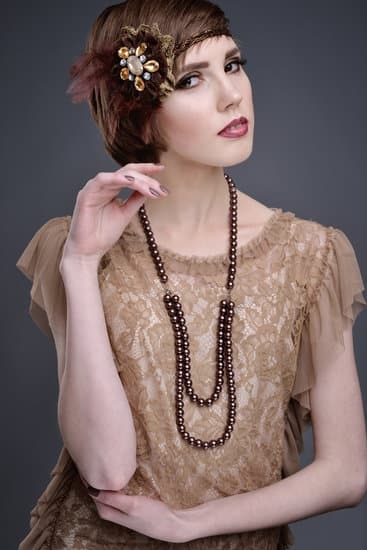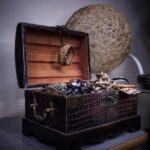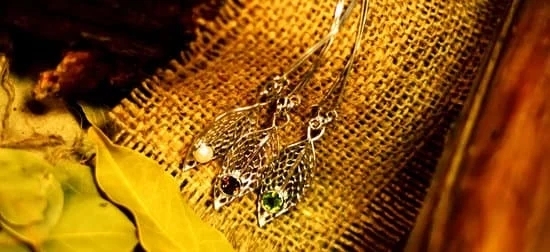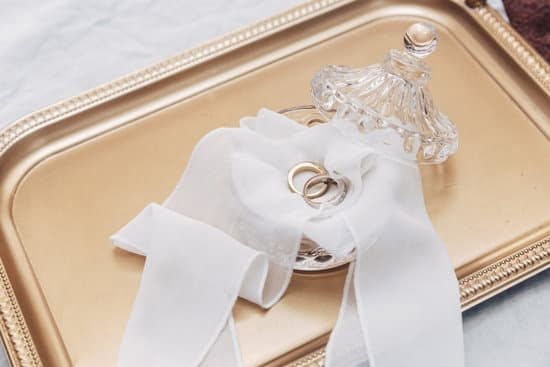The love affair between humans and diamonds is one that has endured for centuries. The elegance, sparkle, and timeless beauty of diamond jewelry have captivated the hearts of countless individuals around the world. However, acquiring genuine diamond pieces can often be a costly endeavor.
That’s where the art of making fake diamond jewelry comes into play. In this article, we will explore the allure of diamond jewelry and discuss why creating your own faux pieces can be a fun and budget-friendly alternative.
Diamonds have long been regarded as a symbol of luxury and status. Their mesmerizing brilliance and durability make them highly sought after in the realm of fine jewelry. However, genuine diamonds also come with a hefty price tag that is not always accessible to everyone. Making fake diamond jewelry allows individuals to indulge their passion for sparkling gems without breaking the bank.
Creating your own faux diamond pieces offers numerous advantages beyond cost savings. It presents an opportunity to unleash your creativity by designing unique and personalized jewelry that perfectly complements your style. With a wide range of materials to choose from, you can experiment with various types of fake diamonds such as cubic zirconia, moissanite, glass, or lab-created diamonds to achieve different looks and effects.
Whether you are a hobbyist looking for a new project or someone who appreciates both the artistry and affordability of DIY crafts, making fake diamond jewelry provides endless possibilities for self-expression. So let’s dive deeper into this fascinating world of imitation gemstones, learn about different techniques and materials used in crafting faux diamonds, gather the necessary supplies, and embark on a creative journey filled with sparkle and glamor.
Understanding Different Types of Fake Diamonds
Fake diamond jewelry is a popular alternative to the real thing, offering affordability and a wide range of design options. There are several materials and techniques used to create these imitation diamonds, each with their own unique properties and characteristics. Understanding the different types of fake diamonds can help you make an informed decision when selecting materials for your DIY jewelry projects.
One common material used in fake diamond jewelry is cubic zirconia. This synthetic gemstone closely resembles a diamond in appearance and durability. It is made from zirconium dioxide and can be faceted to sparkle like a real diamond. Another material used is moissanite, which is composed of silicon carbide. Moissanite has similar optical properties to that of a diamond, making it difficult to distinguish between the two. It also has excellent durability, making it suitable for everyday wear.
Glass is another option for creating fake diamond jewelry. While glass may not have the same level of brilliance as natural diamonds or other synthetic materials, it can still provide a beautiful sparkle at a lower cost. Glass gems can be cut and shaped into various designs, making them versatile for different jewelry pieces.
Lab-created diamonds are another popular choice for fake diamond jewelry. These diamonds are grown in laboratories through high-pressure, high-temperature (HPHT) or chemical vapor deposition (CVD) processes. Lab-created diamonds have the same physical and chemical properties as natural diamonds but can be produced at a fraction of the cost.
| Material | Description |
|---|---|
| Cubic Zirconia | Synthetic gemstone made from zirconium dioxide; closely resembles the appearance of a diamond |
| Moissanite | Synthetic gemstone made from silicon carbide; has similar optical properties to a diamond and high durability |
| Glass | Transparent material that can be shaped and cut into various designs for fake diamond jewelry; offers a lower cost option |
| Lab-Created Diamonds | Diamonds grown in laboratories through HPHT or CVD processes; have the same properties as natural diamonds but at a lower cost. |
Understanding the different types of fake diamonds allows you to choose the material that best suits your needs and preferences. Whether you prefer the affordability and versatility of cubic zirconia or the durability and resemblance to natural diamonds offered by moissanite or lab-created diamonds, there is a fake diamond material out there for every budget and style.
Gathering the Necessary Materials
When it comes to making fake diamond jewelry, gathering the necessary materials is crucial in order to achieve the desired result. Here is a comprehensive list of all the supplies you will need for this DIY project:
- Base materials: Depending on the type of jewelry you want to create, you will need various base materials such as metal wire or sheet, metal findings (such as earring posts or bracelet clasps), or pre-made jewelry settings.
- Gemstones: To mimic the appearance of real diamonds, you can choose from a variety of options like cubic zirconia, moissanite, glass crystals, or lab-created diamonds. Consider the size and cut of the gemstones based on your design preference.
- Adhesives: In order to secure the gemstones to their settings, you will need strong adhesives specifically designed for jewelry making. Look for adhesives that are clear and dry quickly for a clean and professional finish.
- Tools: To create fake diamond jewelry, you’ll need a set of basic jewelry-making tools including needle-nose pliers, wire cutters, round-nose pliers, and adhesive applicators. These tools will help you shape the metal bases, set gemstones securely, and add intricate details.
In addition to these essential supplies, you may also want to consider other optional accessories like jump rings (for connecting different components), chain or cord (for necklaces), charms (for added embellishments), and clasps (for closures). These additional supplies can enhance your designs and give your fake diamond jewelry a unique touch.
Before diving into this DIY project, it’s important to have all these necessary materials readily available. This way, you can seamlessly move onto choosing your design and setting options without any delays. So gather your supplies and get ready to unleash your creativity through making beautiful fake diamond jewelry.
Choosing the Design and Setting
When it comes to making fake diamond jewelry, choosing the right design and setting is crucial in achieving a realistic and aesthetically pleasing piece. Here are some tips to help you select the perfect design for your faux diamonds:
- Solitaire Rings: Solitaire rings are a classic choice that showcases the beauty of a single gemstone. Opt for a prong or bezel setting to securely hold your fake diamond in place. Consider different band styles such as plain bands, twisted bands, or pave bands to add unique touches to your ring.
- Tennis Bracelets: Tennis bracelets are elegant and timeless pieces that feature a continuous line of gemstones. For a fake diamond tennis bracelet, choose a setting that allows the stones to shine brightly while ensuring they are securely set. Popular settings include prong settings or channel settings.
- Statement Necklaces: If you want to make a bold fashion statement with your fake diamond jewelry, consider creating a stunning statement necklace. Choose an eye-catching pendant design that features larger faux diamonds or cluster settings for maximum impact. Pair it with a delicate chain or go for chunkier options depending on your desired look.
In addition to these popular options, there are countless other designs and settings to explore when crafting your own fake diamond jewelry. Whether you prefer dainty and delicate pieces or bold and glamorous ones, let your personal style guide you in finding the perfect design.
Furthermore, consider factors like the size and shape of the gemstones you want to use as well as the overall aesthetic you wish to achieve. Remember that each design choice will contribute to the final appearance of your faux diamond jewelry.
By carefully considering these tips and exploring various designs and settings, you can create beautiful pieces of fake diamond jewelry that rival their real counterparts in both style and charm. So, let your imagination run wild and have fun experimenting with different designs to create jewelry that reflects your unique taste and personality.
Crafting Fake Diamond Rings
Creating your own fake diamond rings can be a fulfilling and budget-friendly way to add some sparkle to your jewelry collection. With a few simple steps and some basic supplies, you can craft stunning rings that mimic the beauty of real diamonds. This section will provide you with step-by-step instructions on how to create your own fake diamond rings, from shaping the base metal to setting the gemstones and adding intricate details for a realistic look.
- Shaping the Base Metal: Start by selecting a suitable base metal for your ring. Common options include sterling silver, gold-plated brass, or stainless steel. Cut a piece of wire or sheet metal according to the desired ring size using jewelry pliers or shears. Use a ring mandrel or cylindrical object to shape the metal into a ring band by wrapping it around and adjusting its size as needed.
- Setting the Gemstone: Once you have shaped the base metal into a ring band, it’s time to set the gemstone. Choose a cubic zirconia or lab-created diamond that closely resembles real diamonds in terms of color and cut. Place the gemstone onto the ring band and secure it using prongs or bezel settings. To ensure stability and longevity, make sure that the prongs are tight enough to hold the gemstone securely in place.
- Adding Intricate Details: To enhance the realism of your fake diamond ring, consider adding intricate details such as filigree work or pave settings. Filigree involves creating delicate designs with thin wires, while pave settings involve embedding small gemstones closely together into the surface of the ring band for an elegant sparkly effect. Use small jewelry files and soldering techniques if necessary to achieve these intricate details.
By following these steps, you can create stunning fake diamond rings that closely resemble the real thing. Experiment with different designs and settings to personalize your creations and make them truly unique. Remember, making your own fake diamond rings is a fun and creative way to express your style while staying within budget.
| Materials | Tools |
|---|---|
| Base metal (e.g., sterling silver, gold-plated brass, stainless steel) | Jewelry pliers or shears |
| Cubic zirconia or lab-created diamonds | Ring mandrel or cylindrical object |
| Prongs or bezel settings | Jewelry files |
| Filigree wires (optional) | Soldering equipment (optional) |
Creating Fake Diamond Earrings
Creating stunning fake diamond earrings can be a fun and creative way to enhance your jewelry collection. Whether you prefer classic studs, elegant hoops, or statement drop earrings, there are various earring styles that you can explore when making fake diamond jewelry. This section provides a detailed guide on how to make fake diamond earrings, including different earring styles and techniques for securely setting gemstones.
When creating fake diamond stud earrings, start by gathering the necessary materials, such as faux diamonds or cubic zirconia gemstones, earring settings with prongs or bezels, and earring backs. To begin the process, carefully set the gemstones into the earring settings using tweezers or a small pair of pliers. Make sure the stones are secure and aligned properly before attaching the earring backs. This will ensure that your stud earrings have a professional and polished look.
If you prefer hoop earrings with faux diamonds, choose hoop settings that already have built-in holes for attaching the gemstones. After selecting your preferred size of hoop setting, attach the faux diamond stones by carefully looping them onto the hoops. Ensure that each stone is securely affixed to prevent any unintentional loss while wearing the earrings. Finally, close the hoop setting tightly to complete the construction of your beautiful fake diamond hoop earrings.
For those who prefer drop earrings with faux diamonds as their centerpieces, start by selecting an appropriate base material for your earrings such as metal findings or wire frames. From there, attach your chosen faux diamonds onto these bases using jump rings or wire wrapping techniques. Additionally, consider adding additional embellishments like chains or other beads to enhance the overall design of your drop earrings.
By following these techniques and experimenting with different styles and designs, you can create unique and eye-catching fake diamond earrings that will add sparkle to any outfit.
Designing Fake Diamond Necklaces
When it comes to crafting fake diamond necklaces, there are several key elements to consider. From selecting the right chain to creating pendant designs and adding dazzling gemstones, the process of designing these beautiful pieces of jewelry allows for endless creativity and personalization.
One of the first steps in designing a fake diamond necklace is choosing the right chain. There are various options available, such as delicate chains for a more refined look or chunky chains for a bold statement piece.
Consider the length of the necklace as well – shorter lengths work well with pendants that sit closer to the collarbone, while longer lengths allow for more versatile styling options. Keep in mind that the chain will act as a backdrop for your pendant, so select one that complements your design.
Once you have chosen the chain, it’s time to focus on creating pendant designs. The possibilities here are limitless, allowing you to tailor your necklace to your unique style and preferences.
You can opt for classic designs like solitaires or explore more intricate patterns with clusters of smaller gems or geometric shapes. Consider using different types of stone cuts to enhance the appearance of your pendant – options like emerald cut, round brilliant cut, or princess cut can all create stunning visual effects.
Adding dazzling gemstones is another important aspect when designing fake diamond necklaces. While cubic zirconia is often used as an affordable alternative to diamonds, you can also experiment with other gemstones like sapphires or emeralds for added color and vibrancy in your design. Whether you choose a single central gemstone or multiple stones scattered across the pendant, focus on achieving balance and symmetry to create an aesthetically pleasing result.
Designing fake diamond necklaces offers a wonderful opportunity for self-expression and creative exploration. With careful consideration given to selecting chains, creating pendant designs, and incorporating striking gemstones, you can craft one-of-a-kind pieces that rival the beauty of genuine diamond necklaces. Let your imagination run wild and enjoy the process of bringing your design ideas to life.
Enhancing Fake Diamond Jewelry
Adding Colored Gemstone Accents
One way to enhance the overall appearance of your fake diamond jewelry is to incorporate colored gemstone accents. This can add a pop of color and make your piece more visually appealing. When choosing colored gemstones, consider their complimentary or contrasting colors to the fake diamonds.
For example, pairing blue sapphires with clear cubic zirconia or moissanite can create an elegant and sophisticated look. Additionally, you can experiment with different gemstone shapes and sizes to add variety and visual interest to your piece.
Incorporating Other Metals like Gold or Silver
Another way to elevate your fake diamond jewelry is by incorporating other metals like gold or silver into the design. This can give your piece a more luxurious and high-end feel. You can achieve this by using gold-plated or silver-plated base materials for your jewelry, or by adding gold or silver accents through wire wrapping, beading, or chains. Mixing different metals can create a beautiful contrast and make your fake diamond jewelry stand out.
Experimenting with Unique Settings
To make your fake diamond jewelry truly unique, consider experimenting with different settings. Instead of traditional prong settings, you can opt for bezel settings which provide a sleek and modern look. Another option is channel settings where multiple stones are set between two metal bars for added brilliance and a contemporary feel.
You can also explore pave settings where small stones are set closely together to create an illusion of continuous sparkle. By trying out these unique settings, you can give your fake diamond jewelry a distinctive style that sets it apart from others.
By incorporating these innovative ideas into your fake diamond jewelry designs, you can take them to the next level in terms of style and sophistication. Remember that the possibilities for enhancing fake diamond jewelry are endless, so let your creativity shine through as you experiment with different gemstones, metals, and settings.
Caring for Fake Diamond Jewelry
Cleaning Fake Diamond Jewelry
To keep your fake diamond jewelry looking its best, it is important to clean it regularly. However, unlike real diamonds, fake diamonds are often more delicate and require gentler cleaning methods. One effective way to clean your faux diamond jewelry is by using a mild dish soap mixed with warm water.
Gently scrub the jewelry with a soft toothbrush to remove any dirt or residue. Be sure to rinse the jewelry thoroughly and dry it completely before storing or wearing it.
Avoid using harsh chemicals or abrasive cleaners on your fake diamond jewelry, as these can damage the materials or cause them to lose their luster. Additionally, do not expose your faux diamonds to excessive heat or prolonged sunlight, as this can cause fading or discoloration.
Storing Fake Diamond Jewelry
Proper storage is crucial for maintaining the longevity and appearance of your fake diamond jewelry. When you are not wearing your pieces, store them in separate compartments or individual pouches to prevent scratching and tangling. It is also recommended to store them away from other metal or gemstone pieces that could potentially damage them.
Consider investing in a jewelry box with soft fabric lining or purchasing anti-tarnish strips specifically designed for storing jewelry. These strips help absorb moisture and reduce tarnish, keeping your fake diamond jewelry shiny and beautiful.
Maintaining Fake Diamond Jewelry
To ensure long-lasting beauty of your faux diamond jewelry, there are a few additional maintenance tips to keep in mind. Avoid exposing your pieces to chemicals such as hairspray, perfume, lotions, and household cleaning products, as these substances can tarnish or corrode the metals used in the jewelry settings.
Regularly inspect your fake diamond jewelry for loose stones or any signs of wear and tear. If you notice any issues, take the piece to a professional jeweler who specializes in costume or fashion jewelry repairs. They will be able to fix any problems and ensure that your jewelry remains in excellent condition.
By following these expert tips, you can keep your fake diamond jewelry looking stunning for years to come. Taking proper care and maintenance ensures that your DIY creations will continue to shine brightly, allowing you to enjoy the beauty of faux diamonds without the cost or worry associated with real diamonds.
Conclusion
In conclusion, making fake diamond jewelry can be a fun and budget-friendly alternative to purchasing expensive pieces. With the knowledge gained from understanding different types of fake diamonds and gathering the necessary materials, anyone can embark on this DIY project. The design and setting choices are endless, allowing individuals to create unique and personalized pieces that reflect their style.
From crafting stunning fake diamond rings to designing beautiful necklaces and earrings, there is no limit to what can be achieved with fake diamond jewelry. By following step-by-step instructions and employing innovative ideas such as adding colored gemstone accents or experimenting with unique settings, individuals can elevate their creations and make them truly one-of-a-kind.
Maintaining fake diamond jewelry is also simple with expert tips on how to clean, store, and care for these faux pieces. By taking proper care, individuals can ensure longevity and preserve the stunning appearance of their handmade jewelry.
Frequently Asked Questions
How to make a fake diamond at home?
Making a fake diamond at home is not a practical or feasible task. Diamonds are created under immense pressure and heat deep within the Earth’s crust over millions of years, making it impossible to replicate such conditions in a home environment.
Furthermore, the process of creating synthetic diamonds requires high-tech equipment and expertise that is far beyond what an average person can achieve at home. Therefore, attempting to make a fake diamond at home would be both impractical and unlikely to yield any satisfactory results.
What are the best materials for fake diamonds?
When it comes to materials used for creating fake diamonds, there are several options available. One common material used is cubic zirconia (CZ), which is a synthesized form of zirconium dioxide. CZ closely resembles the appearance of a diamond but lacks its physical properties and durability.
Moissanite is another popular alternative for fake diamonds, possessing similar optical properties as natural diamonds but distinct from them chemically. Oxide compounds such as spinel, yttrium aluminum garnet (YAG), or strontium titanate are also occasionally used for creating imitation diamond stones.
What do they use to make fake diamonds?
Various materials are employed in making fake diamonds, most commonly referred to as simulant or synthetic gemstones. In the case of cubic zirconia (CZ), it is created by heating powdered zirconium oxide with other elements at temperatures reaching around 4,982°F (2,750°C). Moissanite, on the other hand, features silicon carbide that undergoes high-temperature processes prior to forming crystals suitable for jewelry use.
Other simulant materials like spinel or strontium titanate involve different chemical compositions and synthesis methods specific to each substance. These materials attempt to imitate the visual characteristics of a diamond while lacking its geological formation and exceptional hardness acquired over time.

Welcome to my jewelry blog! My name is Sarah and I am the owner of this blog.
I love making jewelry and sharing my creations with others.
So whether you’re someone who loves wearing jewelry yourself or simply enjoys learning about it, be sure to check out my blog for insightful posts on everything related to this exciting topic!





